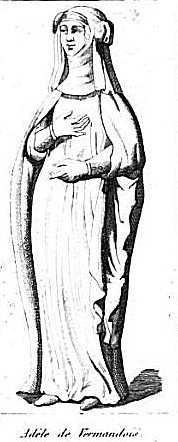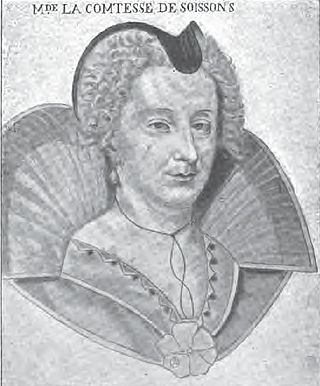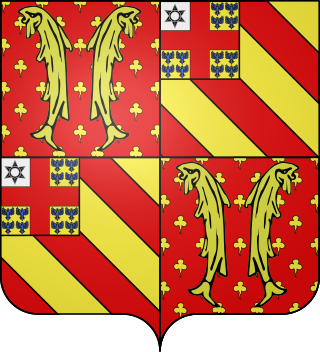Raoul is a French variant of the male given name Ralph or Rudolph.
The Sire de Bourbon or Seigneur de Bourbon, meaning Lord of Bourbon, was the title by which the rulers of the Bourbonnais were known, from 913 to 1327, and from which the cognomen of the royal House of the same name derives. Louis I, count of Clermont, the ultimate holder, was created the first "Duke of Bourbon" and made "count of La Marche" by his cousin, King Charles IV of France, in exchange for Clermont-en-Beauvaisis, thus absorbing the title.

Nesle is a commune in the Somme department in Hauts-de-France in northern France.

The counts of Clermont-en-Beauvaisis first appeared in the early 11th century. Their principal town was Clermont, now in the Oise department but then within the ancient county of Beauvaisis in the province of Île-de-France.
Duval or DuVal is a surname, literally translating from French to English as "of the valley". It derives from the Norman "Devall", which has both English and French ties. Variant spellings include: Davolls, Deavall, DeVile, Devill, Deville, Divall, Divell and de Eyvill. Its meaning is derived from the French town of Deville, Ardennes. "Devall" was first recorded in England in the Domesday Book.
Marie of Ponthieu was suo jure Countess of Ponthieu and Countess of Montreuil, ruling from 1221 to 1250.

Adelaide of Vermandois was suo jure Countess of Vermandois and Valois from 1080 to 1102. She was the last landed ruler of the Carolingian dynasty.

Anne de Montafié, Countess of Clermont-en-Beauvaisis, was a French heiress and the wife of Charles de Bourbon, Count of Soissons, a Prince of the Blood, and military commander during the French Wars of Religion. Following her marriage in 1601, she was styled Countess of Soissons. She was the Countess of Clermont-en-Beauvaisis, Countess of Montafié, Lady of Lucé and Bonnétable in her own right.
Turenne is both a surname, and the seat of various titles of nobility, which therefore end with "de Turenne".

Guy I of Clermont-Nesle was a Marshal of France, Seigneur (Lord) of Offemont jure uxoris, and possibly of Ailly, Maulette and Breteuil. He might have been a Seigneur of Nesle also, or used the title "Sire of Nesle" due to his family. Difficulties about the seigneurie of Breteuil are present, and the status of Ailly and Maulette in relation to Breteuil.

Simon II of Clermont-Nesle was Seigneur (Lord) of Ailly, Maulette and Nesle
Simon of Clermont-Nesle, Peer of France and bishop of Noyon (1297–1301) and Bishop-count of Beauvais.
The Counts of Dammartin were the rulers of the county of Dammartin, based in the current commune of Dammartin-en-Goële as early as the 10th century. Located at the central plain of France, the county controlled the roads of Paris to Soissons and Laon. It seems that this county was initially held by Constance, the wife of Manasses Calvus, the first Count. The name Dammartin-en-Goële comes from Domnus Martinus, the Latin name of St. Martin of Tours, who evangelized the region of Goële in the fourth century. A small town in the district of Meaux in the Department of Seine-et-Marne, ancient village of Region of Île-de-France, it appears to go back to the earliest times; Dammartin-en-Goële, also called Velly, was in 1031 one of the most significant places in France.
Raoul I the Red of Clermont was a French nobleman, and Count of Clermont-en-Beauvaisis from 1161 until his death. He was the eldest son of Renaud II, Count of Clermont-en-Beauvaisis, and his second wife and thus a younger half-brother of Margaret of Clermont.
Raoul of Clermont or Ralph of Clermont is the name of:
The House of Nesle is a feudal family that spawned a long line of Counts of Soissons and eventually merged with the House of Clermont. Nesle is a commune in northern France near Saint-Quentin, Aisne.
Renaud II of Clermont was son of Hugh I, Count of Clermont-en-Beauvaisis and Marguerite de Roucy. Renaud became Count of Clermont-en-Beauvaisis upon his father's death in 1101.
The House of Clermont is a noble family of the French region of Picardy dating from the 10th century and included both the early counts of Clermont-en-Beauvaisis as well as many Constables of France. The house eventually merged with the House of Nesle with the marriage of Raoul II of Clermont and Gertrude of Nesle. The family is the sometimes referred to as the House of Clermont-Nesle.
Margaret of Clermont was a countess consort of Flanders twice by marriage to Charles I, Count of Flanders and Thierry, Count of Flanders. She was ruling suo jure countess regnant of Amiens 1118–1132.
Catherine of Clermont was the ruling Countess of Clermont-en-Beauvaisis in her own right in 1191-1213. She was also the Countess of Blois by marriage.





